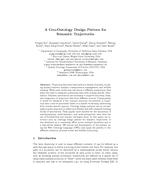A Geo-ontology Design Pattern for Semantic Trajectories
Aus International Center for Computational Logic
A Geo-ontology Design Pattern for Semantic Trajectories
Yingjie HuYingjie Hu, Krzysztof JanowiczKrzysztof Janowicz, David CarralDavid Carral, Simon ScheiderSimon Scheider, Werner KuhnWerner Kuhn, Gary Berg-CrossGary Berg-Cross, Pascal HitzlerPascal Hitzler, Mike DeanMike Dean, Dave KolasDave Kolas
Yingjie Hu, Krzysztof Janowicz, David Carral, Simon Scheider, Werner Kuhn, Gary Berg-Cross, Pascal Hitzler, Mike Dean, Dave Kolas
A Geo-ontology Design Pattern for Semantic Trajectories
In Thora Tenbrink, John G. Stell, Antony Galton, Zena Wood, eds., Spatial Information Theory - 11th International Conference, {COSIT} 2013, Scarborough, UK, . Proceedings, volume 8116 of Lecture Notes in Computer Science, 438-456, September 2013. Springer
A Geo-ontology Design Pattern for Semantic Trajectories
In Thora Tenbrink, John G. Stell, Antony Galton, Zena Wood, eds., Spatial Information Theory - 11th International Conference, {COSIT} 2013, Scarborough, UK, . Proceedings, volume 8116 of Lecture Notes in Computer Science, 438-456, September 2013. Springer
- KurzfassungAbstract
Trajectory data have been used in a variety of studies, including human behavior analysis, transportation management, and wildlife tracking. While each study area introduces a different perspective, they share the need to integrate positioning data with domain-specific information. Semantic annotations are necessary to improve discovery, reuse, and integration of trajectory data from different sources. Consequently, it would be beneficial if the common structure encountered in trajectory data could be annotated based on a shared vocabulary, abstracting from domain-specific aspects. Ontology design patterns are an increasingly popular approach to define such flexible and self-contained building blocks of annotations. They appear more suitable for the annotation of interdisciplinary, multi-thematic, and multi-perspective data than the use of foundational and domain ontologies alone. In this paper, we introduce such an ontology design pattern for semantic trajectories. It was developed as a community effort across multiple disciplines and in a data-driven fashion. We discuss the formalization of the pattern using the Web Ontology Language (OWL) and apply the pattern to two different scenarios, personal travel and wildlife monitoring. - Forschungsgruppe:Research Group: Wissensbasierte SystemeKnowledge-Based Systems
@inproceedings{HJCSKBHDK2013,
author = {Yingjie Hu and Krzysztof Janowicz and David Carral and Simon
Scheider and Werner Kuhn and Gary Berg-Cross and Pascal Hitzler
and Mike Dean and Dave Kolas},
title = {A Geo-ontology Design Pattern for Semantic Trajectories},
editor = {Thora Tenbrink and John G. Stell and Antony Galton and Zena Wood},
booktitle = {Spatial Information Theory - 11th International Conference,
{COSIT} 2013, Scarborough, {UK,} . Proceedings},
series = {Lecture Notes in Computer Science},
volume = {8116},
publisher = {Springer},
year = {2013},
month = {September},
pages = {438-456},
doi = {10.1007/978-3-319-01790-7_24}
}
